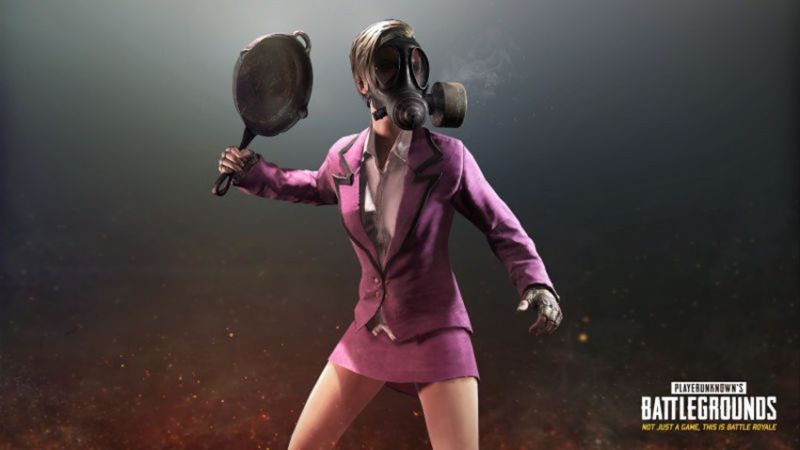
What is surprising is just how uncommon some of these new cosmetic items are. In fact, the rarest free items in PUBG's new crates will only show up for the average serious player once every 80 years, while the rarest paid items will require an average of nearly $1,600 (and five years of dedicated play time) to unlock.
The numbers
We know this because PUBG is being refreshingly upfront about the chances of acquiring specific items in the game's new Desperado and Biker loot crates, which are now available on the game's test server. The fact that platforms like Apple's App Store and countries like China are now requiring such drop rates to be published could have something to do with that transparency, or it could be a coincidence.In any case, we now know that in Biker boxes (which can be opened without spending real money), three of the least common items each only show up 0.01 percent of the time (i.e. a 1 in 10,000 chance). In Desperado boxes (which require a $2.50 "key" purchase to unlock after being purchased with virtual currency) the rarest items show up just 0.16 percent of the time (i.e. in 1 of 625 crates).
Those extreme rarities would already imply a nigh-impossible grind for completionists who want to earn every item in the game on their own. But what makes the odds even worse is PUBG's hard limit of six crate purchases a week, according to the FAQ. That limit applies across all crate types, too; and each purchased crate has only a 40-percent chance of being either a Desperado or Biker crate in the first place (the remaining 20 percent of crates are older Wanderer and Survivor crates, each with different cosmetic items).
That means, if you purchase the maximum six crates a week, you can expect roughly 2.4 of them to be Biker crates and 2.4 to be Desperado crates, on average. To purchase the 10,000 Biker crates that you'd expect to need for a single black Sleeveless Biker jacket would thus take 4,166 weeks, or just under 80 years. For the paid Desperado crates, it would take about five years of maximized crate purchases and $1,562.50, on average, before your first Leopard Cloth Mask showed up.
(You'd also need to earn and spend just over 89.5 million BP through gameplay to buy all those Biker crates, but that's actually not unreasonable over 80 years of dedicated play).
For context, in Overwatch, 7.4 percent of all loot boxes contain one of the game's rarest Legendary items. A Legendary Hearthstone card appears in one of every 20 packs, though the shinier golden Legendary cards appear only about once every 230 packs. In Destiny 2, rare Exotic items appear roughly once in every eight to ten boxes, according to multiple YouTube analyses.
Artificial inflation?
Of course, the PUBG numbers discussed above are just averages (and could change by the time these crates come off the test server). You could be insanely lucky and get one of these ultra-rare items in your very first crate. You could be insanely unlucky and not get even one of these rarest items after hundreds of years of crate purchases (we're assuming your descendants will continue your quest).

In a previous version of the PUBG FAQ, the developers offered the following answer for the question "why are crates expensive?"
The reason crates get more expensive the more you buy is to enforce a soft limit on the number of crates you can buy a week. This creates an economy based on our skins. Limiting the number of crates you can obtain a week is important to make sure there is rarity within items so there’s value in the marketplace.
Indeed, a quick scan of the PUBG marketplace on Steam shows plenty of individual loot crate items going for multiple hundreds of dollars (and that's even if you get rid of "out of print" items that were only available in time-limited crates). With the previous soft limit now switching to a hard limit of six crates per week, the value of the rarest items in these new crates is likely to be at least as high.
Yes, it's great that PUBG players can simply purchase the cosmetic items they want a la carte from other players, rather than simply hoping to get lucky with their limited crate purchases. That said, the artificial limitations on how many of those crates can even exist—and the extreme rarity of the least common items in those crates—means those after-market prices end up much higher than, say, prices for rare in-print Magic the Gathering cards (which are printed at much higher volumes and are much more common, per pack).
Opening a virtual crate with these rarest items is like opening up an envelope with hundred-dollar bills inside, with only a small hurdle of posting it on the Steam marketplace. With that real-world value built in to the secondary market, every in-game crate becomes akin to a lottery scratch-off card.
That kind of small chance of getting an ultra-rare, ultra-valuable item is likely to keep many PUBG players happily playing their way to the next loot crate. But with industry watchers and potential regulators keeping a close eye on the loot crate ecosystem, artificially inflating the market with these hard-to-earn items could be a risky move.
reader comments
153